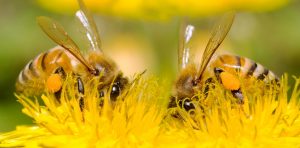The following is from a conversation I had with Susan Knilans, a wonderful women who lives in Oregon and who talks to plants, listens to animals, and absolutely loves the bees.
A: I have been thinking about something you said in your lecture. I was so amazed when you said that bees are ‘the wings of the mineral kingdom’. I have thought about that so much since then and I was wondering if you could elaborate on that concept for me.
S.K.: Yes, the bees and the mineral kingdoms! In biodynamic thinking, the minerals are always on the move, working to heal the planet and to produce abundant life. Weeds are their helpers, moving in to torn up areas to bring in the minerals the area needs to restore itself to full fertility. Bees essentially move the minerals into their new landscapes by pollinating the best of the best plants, and ensuring that they will continue to seed and thrive. In the work of the plants—generated by the gifts of the bees—Earth is restored one mineral at a time. When plants/weeds are no longer needed in an area and begin to become less productive as the minerals change and shift beneath them, the bees don’t bother to pollinate these weakening plants, ensuring that they will die out to be replaced by other plants that can now better serve in that particular niche. That is how I understand it, and I truly believe the truth is much more complex and beautiful than we can imagine!
A: I am so amazed and awed by that process. The intricate interconnectedness of the web of plants and insects and minerals, and all the organic kingdoms, is so incredible and magical.
S.K.: I found myself wondering if the bees also get other “messages” from the mineral kingdom. Bee bodies are so sensitive to communications from pheromones, vibrations, light, pressure, and who can guess what all else.
As example, seals, it turns out, use their whiskers to determine the size of the prey in front of them. In muddy waters, where the seal is essentially blind, it can “sense” what is several feet from its nose through the trembling in the water of its whiskers. It knows, then, if the prey is too big to tangle with (a shark?), or too small to be worth its energy. Scientists only uncovered this aspect of seal biology recently–and I believe accidentally–because we never conceived that seals could use whiskers in that way, and so never tested for it. What other gifts and abilities to bees have (do all other animals have…) that–because they are beyond our comprehension–we never think to look for?
A: It makes so much sense to me that there would be sensitivities in animals, in plants, in minerals, and even in humans, that we can only barely guess at. The relationships between all these families of the Earth are so vast and complex and wondrous, how could it not be that, for all the wonder our imaginations can conjure, the reality of their relationships are far more spectacular than our wildest theory.

Two pollen-laden bees on a dandelion.
(http://www.friendsofthehoneybee.com)
Bees are the wings of the mineral kingdom, the voices of the plants, the midwives of fruits and berries. They work tirelessly to ensure that the cycles of life on this planet continue; their reward is that of being close to the humming mysteries of creation.
These creatures live within a universe of frequencies and sensitivities that connect them deep into the ground, all around the planet, and even to the other planets and stars of our solar system. They listen with their very souls, and hear the messages that the life-force sends to all beings.
Leave a Reply